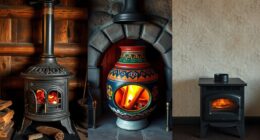When we burn wood, we unleash a hidden world of emissions. These invisible substances have a powerful impact on our air quality, climate, and health.
In this article, I will explore the different types of emissions that are released when we burn wood, from particulate matter to volatile organic compounds.
By understanding these emissions, we can make informed choices about our wood-burning practices and work towards a cleaner and healthier environment for all.
Key Takeaways
- Wood burning releases carbon dioxide (CO2), carbon monoxide (CO), particulate matter (PM), volatile organic compounds (VOCs), nitrogen oxides (NOx), and hazardous air pollutants (HAPs).
- Particulate matter released during wood combustion can lead to reduced air quality, respiratory problems, and increased risk of respiratory infections and lung cancer.
- Transitioning to renewable energy sources and implementing energy efficiency measures can significantly reduce greenhouse gas emissions from wood burning.
- Inhaling high levels of volatile organic compounds (VOCs) from wood burning and other sources can contribute to respiratory issues and the formation of smog.
Types of Emissions From Wood Burning
I’m going to explain the types of emissions that are released when wood is burned.
When wood is burned, it goes through a process called the wood combustion process, which results in the release of various emissions into the atmosphere. These emissions can have significant impacts on air quality and human health, which is why they’re regulated by strict environmental regulations.
One of the primary emissions from wood burning is carbon dioxide (CO2). CO2 is a greenhouse gas that contributes to climate change when released into the atmosphere. It’s important to note that wood is considered a renewable source of energy because the CO2 released during combustion is offset by the CO2 absorbed by the trees during their growth.
Another common emission from wood burning is carbon monoxide (CO). CO is a colorless and odorless gas that’s produced when there’s incomplete combustion of wood. It’s a poisonous gas that can be harmful to human health, especially in enclosed spaces.
Particulate matter (PM) is also released during wood combustion. PM consists of small particles suspended in the air, and it can have detrimental effects on air quality and respiratory health. Wood smoke, which contains PM, has been linked to various respiratory issues, including asthma and bronchitis.
Other emissions from wood burning include volatile organic compounds (VOCs), nitrogen oxides (NOx), and hazardous air pollutants (HAPs). These emissions can contribute to smog formation, acid rain, and other environmental concerns.
Particulate Matter and Its Impact on Air Quality
Burning wood can contribute to the release of particulate matter, which negatively affects air quality. Particulate matter refers to tiny particles suspended in the air, and they can have a detrimental impact on both indoor and outdoor environments. Specifically, when it comes to indoor pollution, burning wood can lead to the following effects:
-
Increased levels of particulate matter: Burning wood releases a significant amount of particulate matter into the air. These particles can be inhaled and cause respiratory problems, particularly for individuals with pre-existing respiratory conditions such as asthma or chronic obstructive pulmonary disease (COPD).
-
Reduced air quality: The release of particulate matter from burning wood can contribute to the overall degradation of indoor air quality. High levels of particulates can lead to irritation of the eyes, nose, and throat, as well as worsening of respiratory symptoms.
-
Negative impact on respiratory health: Exposure to high levels of particulate matter from burning wood can have long-term consequences on respiratory health. Studies have shown that prolonged exposure to particulate matter can increase the risk of respiratory infections, lung cancer, and other respiratory diseases.
It is crucial to be aware of the potential indoor pollution caused by burning wood, as it can have significant implications for respiratory health. Taking steps to minimize exposure to particulate matter, such as using proper ventilation and opting for cleaner burning alternatives, can help improve indoor air quality and protect respiratory health.
Greenhouse Gases and Climate Change
As someone concerned about the environment, it’s important to understand the impact of greenhouse gases on climate change. Greenhouse gases are gases that trap heat in the Earth’s atmosphere, leading to the greenhouse effect and causing global warming. The main greenhouse gases include carbon dioxide (CO2), methane (CH4), nitrous oxide (N2O), and fluorinated gases. These gases are primarily released from human activities such as burning fossil fuels, deforestation, and industrial processes.
To mitigate the effects of greenhouse gases, it’s crucial to implement greenhouse gas reduction strategies. One effective strategy is to shift towards alternative fuel sources that produce fewer greenhouse gas emissions. Renewable energy sources like solar, wind, and hydroelectric power can replace fossil fuels and significantly reduce greenhouse gas emissions. Additionally, promoting energy efficiency and conservation can also contribute to reducing greenhouse gas emissions.
Transitioning to alternative fuel sources and implementing greenhouse gas reduction strategies is vital because volatile organic compounds (VOCs) are another significant contributor to climate change. VOCs are emitted from various sources such as vehicle exhaust, industrial processes, and the use of solvents. In the next section, we’ll explore the effects of VOCs on the environment and their role in air pollution.
Volatile Organic Compounds (VOCs) and Their Effects
Inhaling high levels of volatile organic compounds can cause respiratory issues and contribute to the formation of smog. VOCs are a group of chemicals that are released as gases from certain solids or liquids. They can be found in many products we use every day, such as paints, cleaning supplies, and even some building materials. When these products are used indoors, VOCs can accumulate and affect indoor air quality. To address this issue, there are regulations and control measures in place to limit VOC emissions.
Here are three key points about VOCs and their effects on indoor air quality:
-
Health Impacts: Exposure to high levels of VOCs can lead to a range of health issues, including eye, nose, and throat irritation, headaches, and allergic reactions. Prolonged exposure to certain VOCs, such as benzene and formaldehyde, has been linked to an increased risk of cancer.
-
Indoor Sources: VOCs can be emitted from various sources in our homes and workplaces, such as cleaning products, carpets, furniture, and even cooking. Poor ventilation can lead to higher VOC concentrations indoors, exacerbating the health effects.
-
Regulations and Control Measures: To protect indoor air quality, many countries have established regulations and standards for VOC emissions. These regulations often require the use of low-VOC or VOC-free products, as well as the implementation of ventilation systems to reduce indoor VOC levels.
Health Implications of Wood Burning Emissions
Breathing in the smoke from wood fires can have negative effects on my health. Indoor air pollution caused by wood burning emissions has been linked to various respiratory diseases. When wood is burned, it releases a mixture of harmful pollutants into the air. These pollutants include fine particulate matter (PM2.5), carbon monoxide (CO), nitrogen oxides (NOx), volatile organic compounds (VOCs), and polycyclic aromatic hydrocarbons (PAHs).
Exposure to these pollutants can lead to the development or exacerbation of respiratory diseases such as asthma, bronchitis, and chronic obstructive pulmonary disease (COPD). The fine particulate matter, in particular, can penetrate deep into the lungs and cause inflammation, reduced lung function, and increased risk of respiratory infections. Carbon monoxide can interfere with the delivery of oxygen to the body’s organs and tissues, leading to fatigue, dizziness, and shortness of breath.
Studies have shown that individuals living in areas with high levels of wood smoke exposure have higher rates of respiratory symptoms and hospital admissions for respiratory conditions. Children, the elderly, and individuals with pre-existing respiratory conditions are especially vulnerable to the health effects of wood burning emissions.
To minimize the health risks associated with wood burning, it’s important to promote the use of cleaner technologies, such as EPA-certified wood stoves and pellet stoves, which reduce emissions. Adequate ventilation and proper maintenance of wood-burning appliances can also help to reduce indoor air pollution and protect respiratory health.
Frequently Asked Questions
How Does the Type of Wood Used for Burning Affect the Emissions Released?
When considering the effects of different wood types on emissions and the environmental impact of burning different types of wood, it’s important to understand the role of combustion.
The type of wood used for burning can greatly affect the emissions released. Different wood species have varying levels of moisture content, density, and chemical composition, which can influence the amount and type of pollutants emitted during combustion.
Therefore, the choice of wood for burning should be carefully considered to minimize harmful emissions and reduce environmental impact.
Are There Any Regulations in Place to Control Wood Burning Emissions?
Are there any regulations in place to control wood burning emissions?
The regulatory framework for wood burning emissions varies from country to country. In some regions, there are strict air quality standards that aim to reduce the release of harmful pollutants into the atmosphere.
These regulations may include limits on the types of wood that can be burned, restrictions on the use of certain wood burning appliances, and requirements for proper ventilation and maintenance.
Compliance with these regulations is crucial to ensure cleaner air for everyone.
Can Wood Burning Emissions Contribute to Global Warming?
Wood burning emissions can have a significant impact on air quality and contribute to climate change. When wood is burned, it releases carbon dioxide and other greenhouse gases into the atmosphere. These gases trap heat, leading to a rise in global temperatures and contributing to the greenhouse effect.
Additionally, wood burning can release harmful pollutants such as particulate matter, which can have detrimental effects on human health and the environment.
It’s crucial to regulate and minimize wood burning emissions to mitigate their effects on air quality and climate change.
What Are the Alternatives to Wood Burning for Heating or Cooking?
When it comes to heating or cooking, there are alternatives to wood burning that are more environmentally friendly. Renewable energy sources, such as solar or wind power, can be used to generate electricity for electric appliances. These appliances produce fewer emissions compared to burning wood.
Additionally, electric appliances are more efficient and can provide a consistent source of heat or cooking power. By transitioning to these alternatives, we can reduce our carbon footprint and contribute to a cleaner and greener future.
Are There Any Health Risks Associated With Inhaling Wood Burning Emissions?
When discussing the health risks associated with inhaling wood burning emissions, it’s important to consider the impact of air pollution.
Wood burning releases various pollutants into the air, including particulate matter and harmful gases such as carbon monoxide. These emissions can have detrimental effects on respiratory health and can contribute to the development of respiratory diseases.
It’s crucial to be aware of these risks and take necessary precautions to minimize exposure to wood burning emissions.
Conclusion
In conclusion, burning wood releases a variety of emissions that have significant impacts on air quality, climate change, and human health. These emissions include particulate matter, greenhouse gases, and volatile organic compounds.
Similar to a dense fog settling over a meadow, these emissions blanket our atmosphere, posing risks to both the environment and our well-being.
Understanding the consequences of wood burning is crucial in developing sustainable alternatives and mitigating the harmful effects on our planet and ourselves.





